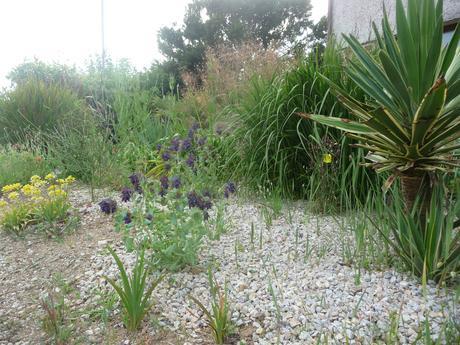When we moved to our current house almost fifteen years ago we inherited a blank canvas. We had the  house built and the front garden is south facing but very exposed and open to winds from all directions. The topsoil was removed before the build began but we were lucky enough to get some delivered for nothing once we were ready to make the garden. The soil is not deep but the underlying subsoil is very free draining which coupled with the sunny aspect, make it an ideal site for a low maintenance gravel garden.
house built and the front garden is south facing but very exposed and open to winds from all directions. The topsoil was removed before the build began but we were lucky enough to get some delivered for nothing once we were ready to make the garden. The soil is not deep but the underlying subsoil is very free draining which coupled with the sunny aspect, make it an ideal site for a low maintenance gravel garden.
Low, mound-like evergreens were planted first including the gray leaved Hebe pinguifolia ‘Pagei’ and sticky leaved Cistus x hybridus which always makes such a neat shape and is covered with glowing white flowers in early summer that the bees love so much. Cotton Lavender (Santolina) also makes a neat evergreen shrub with aromatic leaves and yellow flowers like buttons held on wiry stems in summer. I prefer the deep green leaves of Santolina virens to the silver leaved varieties – the flowers contrast much better.
For height on the windward side we planted a tough Phormium tenax ‘Purpureum’ in front of a ‘hit and miss’ fence which filters the worst of the winter gales. Taller Hebes also thrive here and have to be cut back hard every couple of years in early spring to keep them in shape. Grasses are a great addition to any garden but here, they defy even the most violent of summer winds, flexing and swaying without stems breaking.
With the bones of this area well established, we introduced some smaller plants which love the hot dry conditions. Rock Roses (Helianthemum) of various colours spread over the gravel and glow when in flower through the summer. Cutting them back hard once they have finished blooming keeps them in shape and makes them live longer than if they are allowed to produce straggly growths. They are available in a rainbow of colours from pure white to deep plum-red and the single flowers are loved by bees. The more unusual double flowered forms are beautiful but no good for pollinating insects – they hold less pollen and are more difficult for insects to navigate.
Low growing Euphorbia myrsinites (Spurge) flops its long stems over the stones and produces flat heads of flowers in late spring. They are acid green and contrast beautifully with the grey-blue evergreen leaves. This along with a prostrate form of Evening Primrose (Oenothera macrocarpa), relish the dry conditions and are easily raised from seed. The exotic, saucer shaped blooms of the Evening Primrose belie its hardiness – the plant sensibly dies to ground level in the winter but will appear each year as long as the soil drains well in persistent wet weather. We have another self seeded form of this lovely plant which is upright growing and has smaller yellow blooms which open at night and have a delicious scent.
The stars of the show right now are Cerinthe major var. purpurascens (Honeywort) and Allium moly. The Allium is slowly seeding around this area, loving the free draining gravel and the fact that we only pull out seedlings that we can identify as weeds! The bright yellow heads of star shaped flowers are popping up at random and always make me smile. Allium christophii which were planted on a bed of coarse grit last winter have also been outstanding and will hopefully produce offspring of their own in future years.
I have always loved the look of Cerinthe and finally remembered to buy some seed this spring. It germinated very quickly in the propagator and the silvery gray leaves soon made sturdy plants that were ready to grow on in small pots until they were established enough to go into the garden. They have grown into the most beautiful plants with amazing flower clusters that are remarked on by neighbours as they pass by – a definite winner which should also seed easily and create a colony over the next few years.
When an area of the garden does well, it inspires me to try new things and start again with other areas which are no longer up to the mark – what next I wonder?
